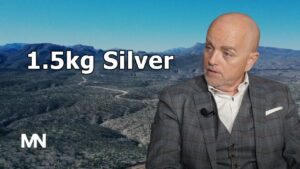VANCOUVER, BC, June 26, 2024 /CNW/ – Orla Mining Ltd. (TSX: OLA) (NYSE: ORLA) (“Orla” or the “Company”) is pleased to provide an update on its exploration activities at Camino Rojo Sulphide Extension from the first half of 2024.
Highlight results:
- 4.57 g/t Au, 19.4 g/t Ag, 2.56% Zn, (6.16 g/t AuEq) over 15m, incl. 51.1 g/t Au, 8.08% Zn over 0.8m
- 6.72 g/t Au, 7.7 g/t Ag, 0.79% Zn (7.24 g/t AuEq) over 6.6m, incl. 78.6 g/t Au, 8.24% Zn over 0.5m
- 3.49 g/t Au, 7.60 g/t Ag, 1.06% Zn (4.12 AuEq) over 9.8m, incl. 16.6 g/t Au, 5.63% Zn over 1.5m
- 86% gold recovery rate via bottle roll tests
2024 Camino Rojo Extension Exploration Results (Mexico):
This press release provides results from 19 drill holes and 13,500 metres drilled as part of the 30,000-metre Camino Rojo Extension drill program planned for 2024. To date, 13 significant mineralized drill intersections outside the current resource have been identified, with a grade-by-thickness factor exceeding 30 g/t AuEq per metre (g/t*m). The estimated true width of these intersections ranges from 5.7 to 21.4 metres. Narrower intervals, ranging from 0.4 to 1.6 metres, returned higher gold grades of 10.0 g/t to 78.6 g/t, and zinc values from 1.0% to 18.8%, often as part of wider zones of polymetallic mineralization ranging from a few metres to several tens of metres in core length.
Metallurgical Testing:
Cyanide bottle roll test work on the recent Extension drill holes showed an 86% gold recovery rate, rougher flotation yielded 84% gold recovery, and open-circuit zinc cleaner tests produced a concentrate grading 51.3% zinc and a 94% zinc recovery rate. These positive metallurgical results are consistent with the results of last year’s gold recoveries of 81%-96% for bottle roll and 85%-88% for rougher flotation, highlighting the potential compatibility of this new mineralization style with both standard cyanide processing and flotation methods.
Future Exploration Plans:
The drill results indicate potential expansion of the Camino Rojo Sulphide resource at depth, extending beyond the current mineral resource down plunge by 500 metres and down dip by 300 metres. This high-grade polymetallic (Au-Ag-Zn) semi-massive to massive replacement style mineralization remains open at depth. The remainder of the current exploration program will focus on extending mineralization from 0.5 to 1 kilometre down-plunge of the current limit of mineral resources along the dike structures. This drilling is expected to test open mineralized trends and historical high-grade intersections to assess the broader potential of the growing Camino Rojo deposit.
“The 2024 Camino Rojo Extension drill program has yielded exciting results, including multiple significant mineralized intersections outside the current resource and excellent metallurgical testing outcomes. Our team is thrilled about continuing to expand mineralization along the dike structure and unlocking the Camino Rojo deposit’s full growth potential. Stay tuned for more updates as we continue to push the boundaries of exploration and discovery!”
– Sylvain Guerard, Orla’s Senior Vice President, Exploration
Drill hole detailed highlights:
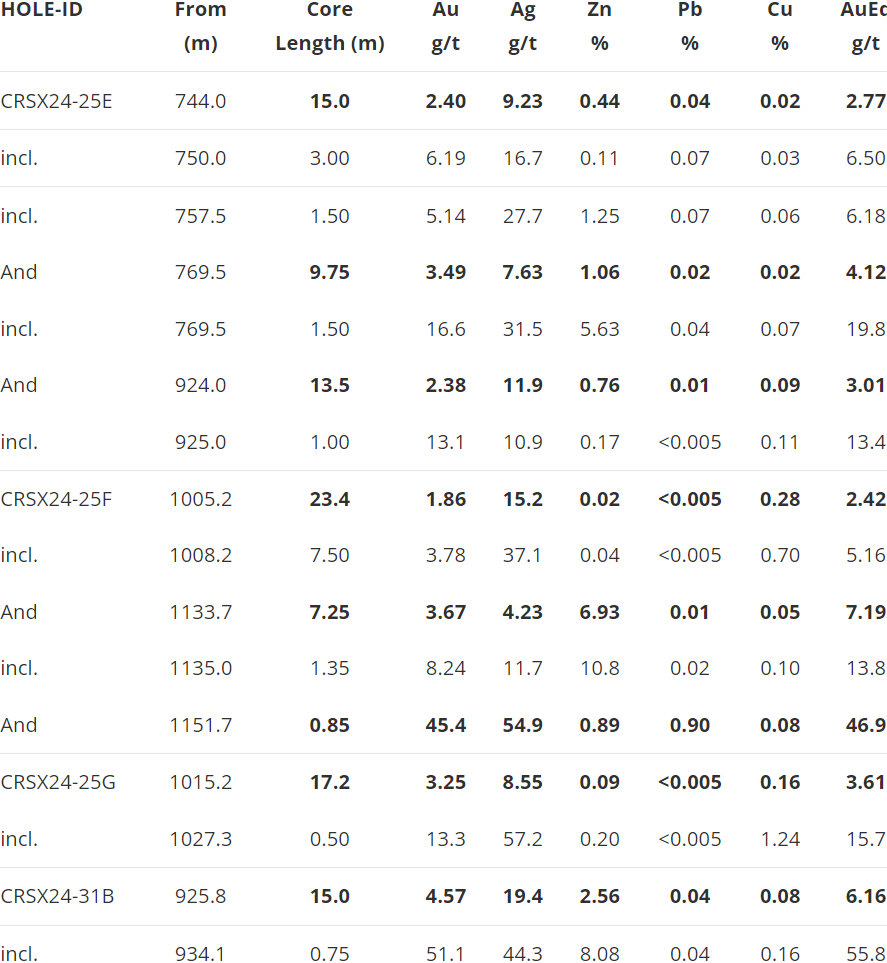

Metal prices used in gold equivalent calculation: Au = $1,750/oz, Ag = $21 / oz, Zn = $1.20/lb, Pb = $0.90/lb, Cu = $3.50/lb. See “Gold Equivalent Calculation” below for additional information. All prices in USD. All composites are in the Camino Rojo Extension.
Significance of Au, Ag, Zn and now Cu results
These first results from the 2024 exploration program demonstrate significant potential for additional gold, silver, and zinc mineralization associated with polymetallic replacement style mineralization beneath the Caracol-hosted sulphide deposit, the main host rock of the current mineral resources. Recent intersections highlight an increase in copper mineralization, extending from approximately 250 to 500 metres down-plunge from the existing resource limit, and remaining open down plunge, adding a new component to the emerging down-plunge extension potential. Notable copper intersections include 0.7% Cu over 7.5 metres (hole CRSX24-25F), 1.24% Cu over 0.5 metres (hole CRSX24-25G), and 2.74% Cu over 1.1 metres (hole CRSX24-36B). The increased copper grades are associated with skarn-type mineralization and alteration, as well as sulphide replacement mineralization. The occurrence of elevated copper values further supports the interpreted main feeder structures of the mineralized system and provides a down-plunge vector for further drilling during the remainder of the ongoing program.
The geometry of polymetallic replacement style mineralization consists of shallow-dipping, bedding-parallel, and steep-dipping, dike-parallel domains. This mineralization extends at least 500 metres down-plunge from the existing resource and 50 to 250 metres laterally from the dike structures and other secondary interpreted feeder structures.
All mineralized interval lengths reported are down-hole intervals, with true width estimates ranging from 60-98% of the reported interval for all composites >5 grade-by-thickness factor (Au g/t*m). See Table 1 in the Appendix of this news release for estimated true widths of individual composites. A standard sampling length of 1.5 metre is used with a minimum of 0.5 metre when required based on geologic contacts. Drill core is mainly HQ diameter, with reduction to NQ where necessary due to drilling depth. The reported composites were not subject high to “capping”. Orla believes that applying a top cut would have a negligible effect on overall grades. Composites for the sulphide drilling were calculated using 1.0 g/t Au cut-off grade and maximum 6 metres consecutive waste.
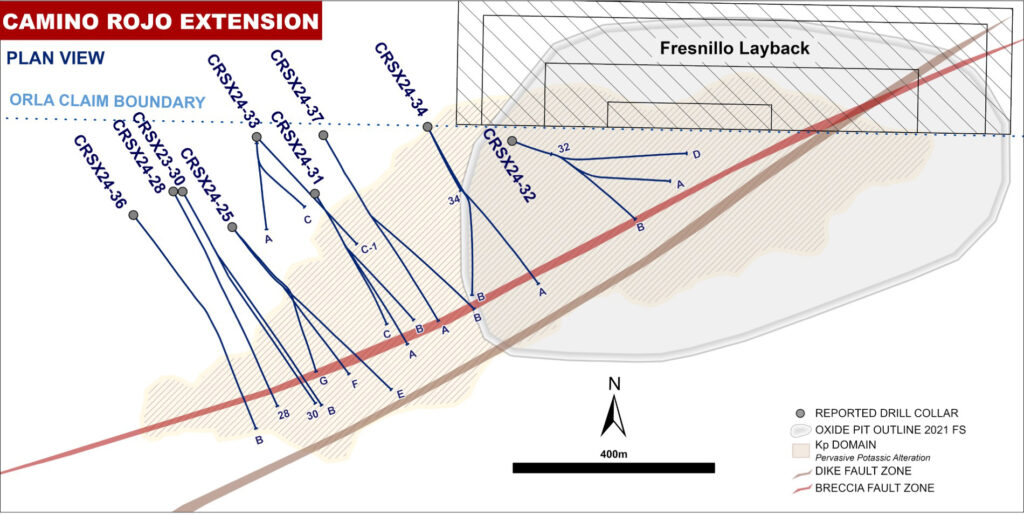
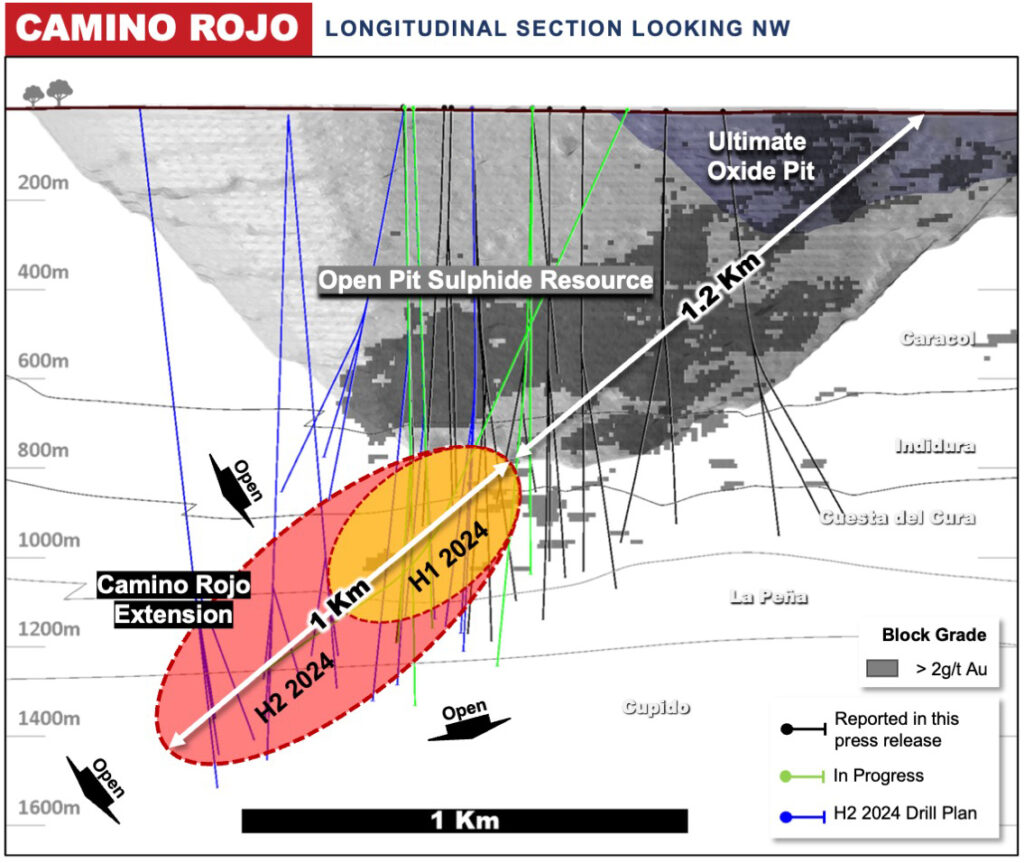
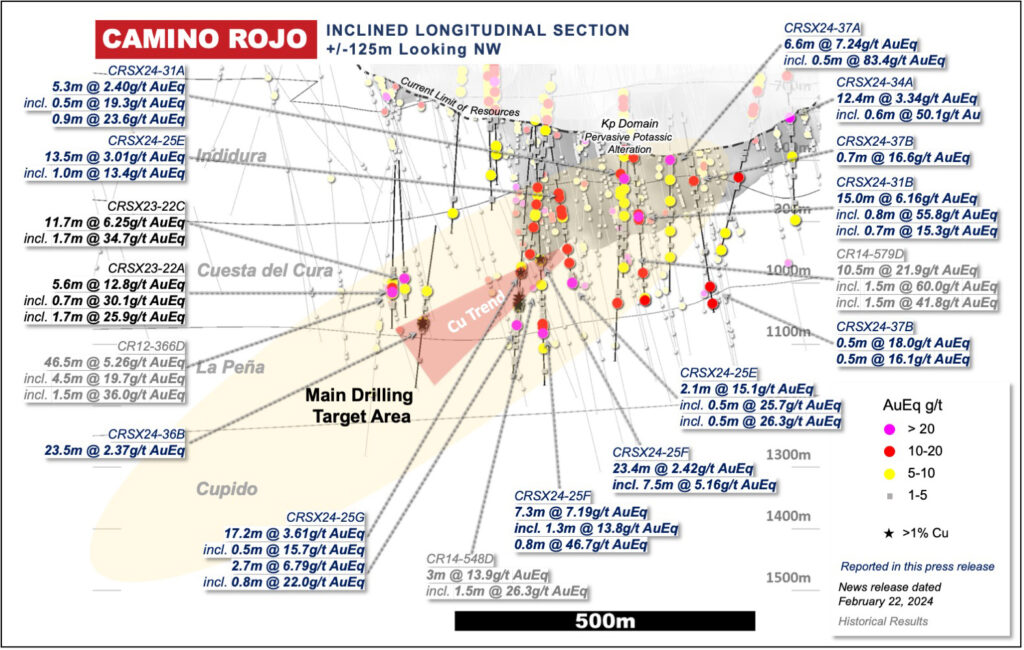
Metal prices used in gold equivalent calculation: Au = $1,750/oz, Ag = $21 / oz, Zn = $1.20/lb, Pb = $0.90/lb, Cu = $3.50/lb. See “Gold Equivalent Calculation” below for additional information. All prices in USD. All composites are in the Camino Rojo Extension.
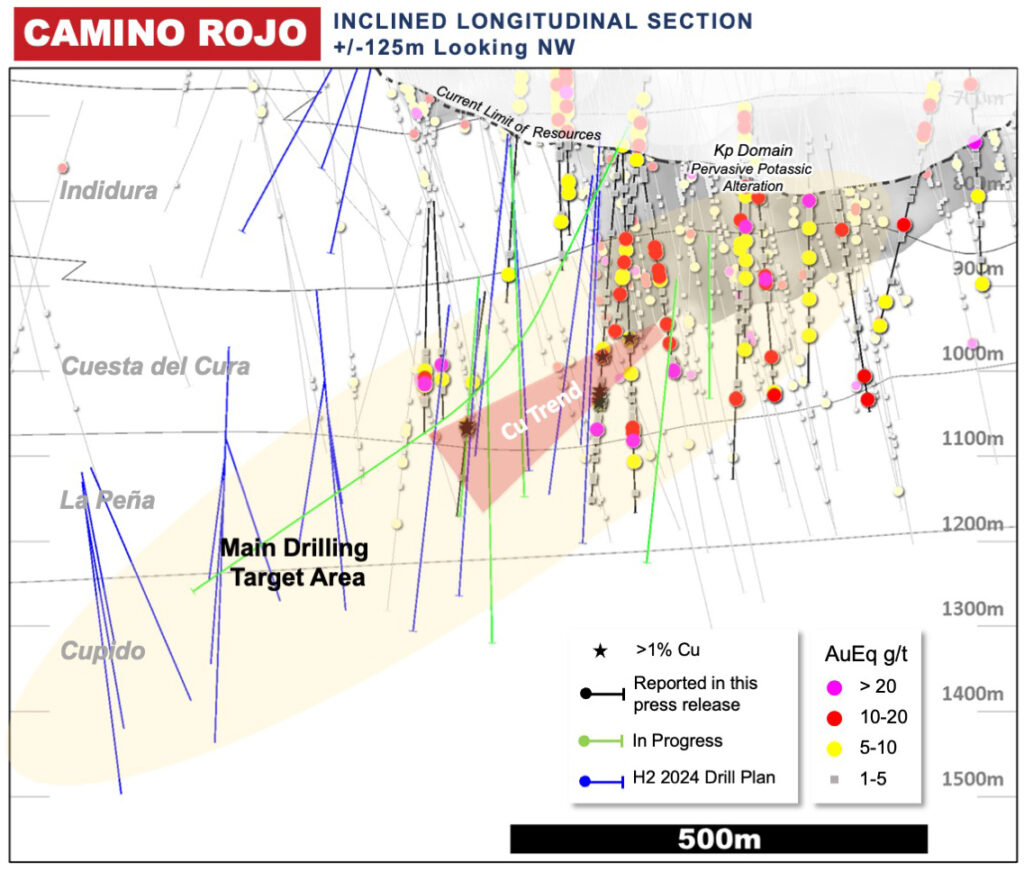

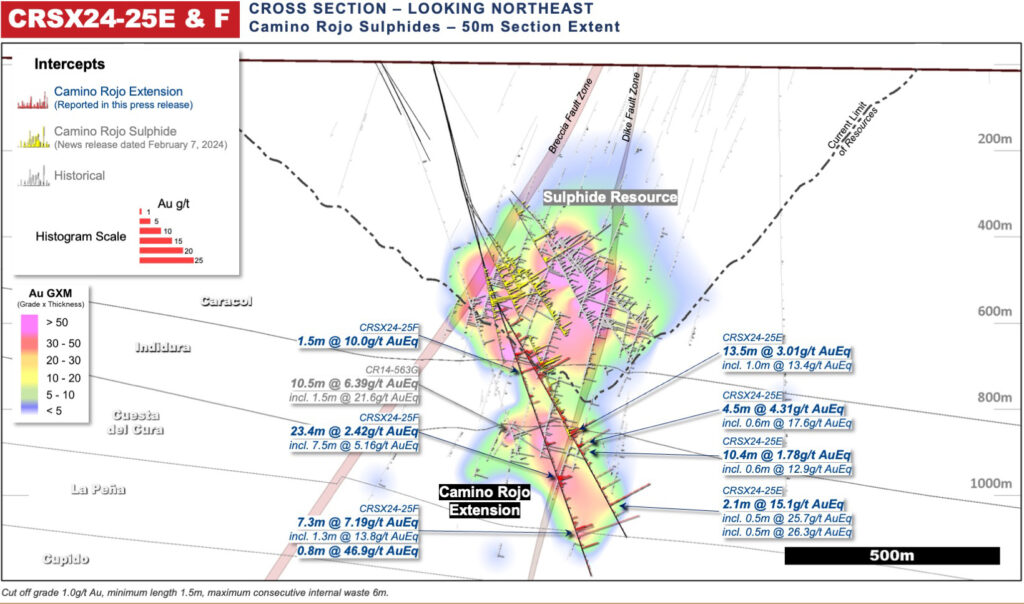
Qualified Persons Statement
The scientific and technical information in this news release has been reviewed and approved by Mr. Sylvain Guerard, P Geo., SVP Exploration of the Company, who is the Qualified Person as defined under the definitions of National Instrument 43-101 (“NI 43-101”).
To verify the information related to the 2024 drilling programs at the Camino Rojo property, Mr. Guerard has visited the property in the past year; discussed logging, sampling, and sample shipping processes with responsible site staff; discussed and reviewed assay and QA/QC results with responsible personnel; and reviewed supporting documentation, including drill hole location and orientation and significant assay interval calculations.
Quality Assurance / Quality Control –2024 Drill Program
All gold results at Camino Rojo were obtained by ALS Minerals (Au-AA23) using fire assay fusion and an atomic absorption spectroscopy finish. All samples are also analyzed for multi-elements, including silver, copper, lead and zinc using a four-acid digestion with ICP-AES finish (ME-ICP61) method at ALS Laboratories in Canada. If samples were returned with gold values in excess of 10 ppm or base metal values in excess of 1% by ICP analysis, samples are re-run with gold (Au-GRA21) by fire assay and gravimetric finish or base metal by (OG62) four acid overlimit methods. Drill program design, Quality Assurance/Quality Control and interpretation of results were performed by qualified persons employing a Quality Assurance/Quality Control program consistent with NI 43-101 and industry best practices. Standards were inserted at a frequency of one in every 50 samples, and blanks were inserted at a frequency of one in every 50 samples for Quality Assurance/Quality Control purposes by the Company as well as the lab. ALS Minerals and ALS Laboratories are independent of Orla. There are no known drilling, sampling, recovery, or other factors that could materially affect the accuracy or reliability of the drilling data at Camino Rojo.
For additional information on the Company’s previously reported drill results, see the Company’s press releases dated February 4, 2021 (Orla Mining Provides Exploration Update), September 12, 2022 (Orla Mining Advances Exploration & Growth Pipeline), January 31, 2023 (Orla Mining Continues to Intersect Wide, Higher-Grade Sulphide Zones and Expose Deeper Potential at Camino Rojo, Mexico) and February 7, 2024 (Orla Mining Concludes 2023 Camino Rojo Sulphides Infill Program with Strong Results). Historical drill results at Camino Rojo were completed by Goldcorp. Inc. (“Goldcorp”), a prior owner of the project. The Company’s independent qualified person, Independent Mining Consultants, Inc. was of the opinion that the drilling and sampling procedures for Camino Rojo drill samples by Goldcorp (and prior to its acquisition by Goldcorp, Canplats Resources Corporation) were reasonable and adequate for the purposes of the Camino Rojo Report, and that the Goldcorp QA/QC program met or exceeded industry standards. See the Camino Rojo Report for additional information.
Gold Equivalent Calculations
The following metal prices in USD were used for the gold metal equivalent calculations: $1,750/oz gold, $21/oz silver, $0.90/lb lead, $1.20/lb zinc, and $3.50/lb copper. Metal recoveries on the Sulphide Extension, based on the total recovery for the sulphide portion of the existing resource estimate, were 86% for gold, 76% for silver, 60% for lead, and 64% for zinc, and based on a preliminary study of similar carbonate replacement deposits were assumed to be 85% for copper. Metal recoveries on the Camino Rojo Extension, based on a preliminary metallurgical study, were 88% for gold and 92% for zinc, and based on a preliminary study of similar carbonate replacement deposits were assumed to be 85% for silver, 85% for lead and 85% for copper.
The following equations were used to calculate gold equivalence:
- Camino Rojo Sulphide AuEq = Au (g/t) + [ Ag (g/t) * 0.0106] + [ Pb (%) * 0.2460 ] + [ Zn (%) * 0.3499 ] + [ Cu (%) * 1.3555 ]
- Camino Rojo Extension AuEq = Au (g/t) + [ Ag (g/t) * 0.0116] + [ Pb (%) * 0.3406 ] + [ Zn (%) * 0.4916 ] + [ Cu (%) * 1.3247 ]
Analyzed metal equivalent calculations are reported for illustrative purposes only. The metal chosen for reporting on an equivalent basis is the one that contributes the most dollar value after accounting for the recoveries used above.
About Orla Mining Ltd.
Orla’s corporate strategy is to acquire, develop, and operate mineral properties where the Company’s expertise can substantially increase stakeholder value. The Company has two material gold projects: (1) Camino Rojo, located in Zacatecas State, Mexico and (2) South Railroad, located in Nevada, United States. Orla is operating the Camino Rojo Oxide Gold Mine, a gold and silver open-pit and heap leach mine. The property is 100% owned by Orla and covers over 139,000 hectares which contains a large oxide and sulphide mineral resource. Orla is also developing the South Railroad Project, a feasibility-stage, open pit, heap leach gold project located on the Carlin trend in Nevada. The technical reports for the Company’s material projects are available on Orla’s website at www.orlamining.com, and on SEDAR+ and EDGAR under the Company’s profile at www.sedarplus.ca and www.sec.gov, respectively.
Forward-looking Statements
This news release contains certain “forward-looking information” and “forward-looking statements” within the meaning of Canadian securities legislation and within the meaning of Section 27A of the United States Securities Act of 1933, as amended, Section 21E of the United States Exchange Act of 1934, as amended, the United States Private Securities Litigation Reform Act of 1995, or in releases made by the United States Securities and Exchange Commission, all as may be amended from time to time, including, without limitation, statements regarding: the potential mineralization at Camino Rojo based on the 2024 drill program, including the potential for additional gold, silver and zinc mineralization, and other statements regarding the remainder of the Company’s 2024 drill program, including the expected benefits and results thereof. Forward-looking statements are statements that are not historical facts which address events, results, outcomes or developments that the Company expects to occur. Forward-looking statements are based on the beliefs, estimates and opinions of the Company’s management on the date the statements are made and they involve a number of risks and uncertainties. Certain material assumptions regarding such forward-looking statements were made, including without limitation, assumptions regarding: the future price of gold and silver; anticipated costs and the Company’s ability to fund its programs; the Company’s ability to carry on exploration, development, and mining activities; tonnage of ore to be mined and processed; ore grades and recoveries; decommissioning and reclamation estimates; currency exchange rates remaining as estimated; prices for energy inputs, labour, materials, supplies and services remaining as estimated; the Company’s ability to secure and to meet obligations under property agreements, including the layback agreement with Fresnillo plc; that all conditions of the Company’s credit facility will be met; the timing and results of drilling programs; mineral reserve and mineral resource estimates and the assumptions on which they are based; the discovery of mineral resources and mineral reserves on the Company’s mineral properties; the obtaining of a subsequent agreement with Fresnillo to access the sulphide mineral resource at the Camino Rojo Project and develop the entire Camino Rojo Project mineral resources estimate; that political and legal developments will be consistent with current expectations; the timely receipt of required approvals and permits, including those approvals and permits required for successful project permitting, construction, and operation of projects; the timing of cash flows; the costs of operating and exploration expenditures; the Company’s ability to operate in a safe, efficient, and effective manner; the Company’s ability to obtain financing as and when required and on reasonable terms; the impact of coronavirus (“COVID-19”) on the Company’s operations; that the Company’s activities will be in accordance with the Company’s public statements and stated goals; and that there will be no material adverse change or disruptions affecting the Company or its properties. Consequently, there can be no assurances that such statements will prove to be accurate and actual results and future events could differ materially from those anticipated in such statements. Forward-looking statements involve significant known and unknown risks and uncertainties, which could cause actual results to differ materially from those anticipated. These risks include, but are not limited to: uncertainty and variations in the estimation of mineral resources and mineral reserves; the Company’s dependence on the Camino Rojo oxide mine; risks related to the Company’s indebtedness; risks related to exploration, development, and operation activities; foreign country and political risks, including risks relating to foreign operations; risks related to the Cerro Quema Project; delays in obtaining or failure to obtain governmental permits, or non-compliance with permits; environmental and other regulatory requirements; delays in or failures to enter into a subsequent agreement with Fresnillo with respect to accessing certain additional portions of the mineral resource at the Camino Rojo Project and to obtain the necessary regulatory approvals related thereto; the mineral resource estimations for the Camino Rojo Project being only estimates and relying on certain assumptions; loss of, delays in, or failure to get access from surface rights owners; uncertainties related to title to mineral properties; water rights; risks related to natural disasters, terrorist acts, health crises, and other disruptions and dislocations, including the COVID-19 pandemic; financing risks and access to additional capital; risks related to guidance estimates and uncertainties inherent in the preparation of feasibility studies; uncertainty in estimates of production, capital, and operating costs and potential production and cost overruns; the fluctuating price of gold and silver; unknown labilities in connection with acquisitions; global financial conditions; uninsured risks; climate change risks; competition from other companies and individuals; conflicts of interest; risks related to compliance with anti-corruption laws; volatility in the market price of the Company’s securities; assessments by taxation authorities in multiple jurisdictions; foreign currency fluctuations; the Company’s limited operating history; litigation risks; the Company’s ability to identify, complete, and successfully integrate acquisitions; intervention by non-governmental organizations; outside contractor risks; risks related to historical data; the Company not having paid a dividend; risks related to the Company’s foreign subsidiaries; risks related to the Company’s accounting policies and internal controls; the Company’s ability to satisfy the requirements of Sarbanes-Oxley Act of 2002; enforcement of civil liabilities; the Company’s status as a passive foreign investment company for U.S. federal income tax purposes; information and cyber security; the Company’s significant shareholders; gold industry concentration; shareholder activism; other risks associated with executing the Company’s objectives and strategies; as well as those risk factors discussed in the Company’s most recently filed management’s discussion and analysis, as well as its annual information form dated March 19, 2024, which are available on www.sedarplus.ca and www.sec.gov. Except as required by the securities disclosure laws and regulations applicable to the Company, the Company undertakes no obligation to update these forward-looking statements if management’s beliefs, estimates or opinions, or other factors, should change.
Cautionary Note to U.S. Readers
This news release has been prepared in accordance with Canadian standards for the reporting of mineral resource and mineral reserve estimates, which differ from the previous and current standards of the United States securities laws. In particular, and without limiting the generality of the foregoing, the terms “mineral reserve”, “proven mineral reserve”, “probable mineral reserve”, “inferred mineral resources,”, “indicated mineral resources,” “measured mineral resources” and “mineral resources” used or referenced herein and the documents incorporated by reference herein, as applicable, are Canadian mineral disclosure terms as defined in accordance with Canadian National Instrument 43-101 — Standards of Disclosure for Mineral Projects (“NI 43-101”) and the Canadian Institute of Mining, Metallurgy and Petroleum (the “CIM”) — CIM Definition Standards on Mineral Resources and Mineral Reserves, adopted by the CIM Council, as amended (the “CIM Definition Standards”). For United States reporting purposes, the United States Securities and Exchange Commission (the “SEC”) has adopted amendments to its disclosure rules (the “SEC Modernization Rules”) to modernize the mining property disclosure requirements for issuers whose securities are registered with the SEC under the Exchange Act, which became effective February 25, 2019. The SEC Modernization Rules more closely align the SEC’s disclosure requirements and policies for mining properties with current industry and global regulatory practices and standards, including NI 43-101, and replace the historical property disclosure requirements for mining registrants that were included in SEC Industry Guide 7. Issuers were required to comply with the SEC Modernization Rules in their first fiscal year beginning on or after January 1, 2021. As a foreign private issuer that is eligible to file reports with the SEC pursuant to the multi-jurisdictional disclosure system, the Corporation is not required to provide disclosure on its mineral properties under the SEC Modernization Rules and will continue to provide disclosure under NI 43-101 and the CIM Definition Standards. Accordingly, mineral reserve and mineral resource information contained or incorporated by reference herein may not be comparable to similar information disclosed by United States companies subject to the United States federal securities laws and the rules and regulations thereunder. As a result of the adoption of the SEC Modernization Rules, the SEC now recognizes estimates of “measured mineral resources”, “indicated mineral resources” and “inferred mineral resources.” In addition, the SEC has amended its definitions of “proven mineral reserves” and “probable mineral reserves” to be “substantially similar” to the corresponding CIM Definition Standards that are required under NI 43-101. While the SEC will now recognize “measured mineral resources”, “indicated mineral resources” and “inferred mineral resources”, U.S. investors should not assume that all or any part of the mineralization in these categories will be converted into a higher category of mineral resources or into mineral reserves without further work and analysis. Mineralization described using these terms has a greater amount of uncertainty as to its existence and feasibility than mineralization that has been characterized as reserves. Accordingly, U.S. investors are cautioned not to assume that all or any measured mineral resources, indicated mineral resources, or inferred mineral resources that the Company reports are or will be economically or legally mineable without further work and analysis. Further, “inferred mineral resources” have a greater amount of uncertainty and as to whether they can be mined legally or economically. Therefore, U.S. investors are also cautioned not to assume that all or any part of inferred mineral resources will be upgraded to a higher category without further work and analysis. Under Canadian securities laws, estimates of “inferred mineral resources” may not form the basis of feasibility or pre-feasibility studies, except in rare cases. While the above terms are “substantially similar” to CIM Definitions, there are differences in the definitions under the SEC Modernization Rules and the CIM Definition Standards. Accordingly, there is no assurance any mineral reserves or mineral resources that the Company may report as “proven mineral reserves”, “probable mineral reserves”, “measured mineral resources”, “indicated mineral resources” and “inferred mineral resources” under NI 43-101 would be the same had the Company prepared the reserve or resource estimates under the standards adopted under the SEC Modernization Rules or under the prior standards of SEC Industry Guide 7.
Appendix: Camino Rojo Sulphide Extension Drill Tables
SOURCE Orla Mining Ltd.
For further information, please contact: Jason Simpson, President & Chief Executive Officer; Andrew Bradbury, Vice President, Investor Relations & Corporate Development, www.orlamining.com, info@orlamining.com
